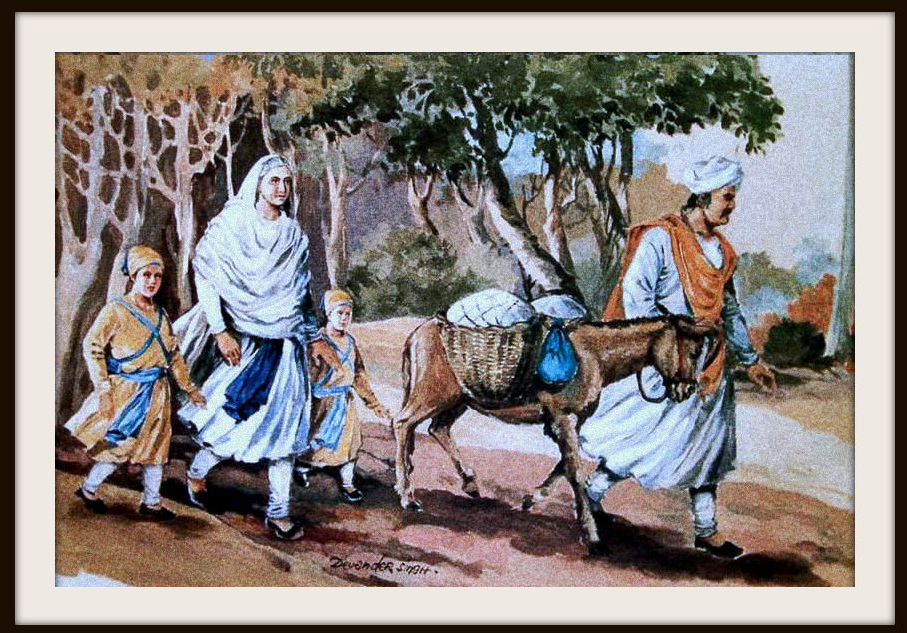Gangu
Gangu, a Saraswat Brahmin, was a server of at Anandpur Sahib who control over the kitchen of Guru Sahib. Gangu was one of the Kashmiri Pandits who came to the court of the ninth Nanak, that is Sat Guru Teg Bahadur Ji, (concerned with threats made by Mughal authorities).[1] Gangu, who was about 25 years at that time, returned to Kashmir, but five years later he returned to the Guru's court, entering the service of Sat Guru Gobind Rai. Gangu was blessed with a son he named Raj Kaul who was raised by his grand parents in Kashmir.
Gangu's role in arrest of Mata Gujri and her grandsons
When Satguru Gobind Singh Ji and the Sikhs left Sri Anandpur Sahib in 1704, Gangu took the lost Mata Gujar Kaur (Mata Gujri Ji) and the two younger sons of Satguru Gobind Singh Ji, to his village of Kherhi (where he and wife had migrated from Kashmir).
There are various versions in the Sikh history about the arrest of Mata Gujri and young sahibzadeys and the role of Gangu.
- The prominient after offering them shelter (but instead of following the age old Hindus saying, “A guest is to be treated like a God”) he went to the authorities. His three guests were arrested, and he was given a reward from the Governor of Sirhind. Gangu who proved himself unworthy of the trust the Guru's family had placed in him not only as the families cook, but in their most urgent time of need. His treachery sealed the fate of the Guru's mother and the two youngest Lions, the Sahibzadis; the youngest Shaheedan who held firm to their fate, freely chosing death rather than bending to the swords of tyranny.
- Another appropriate version of the story of Gangu exists, in which Gangu went to the village 'Headmen' at the insistence of Mata Gujri, as the whole village would quickly learn that the 'hunted' Guru Sahib's aged mother, Mata Gujari and his youngest sons were staying with Gangu, his not telling the the village 'Headmen' of their presence, would in danger Gangu and his family. Mata Gujri and Gangu also discussed that three of them will get released, as per law and Mughal government will not give punishment of Guru Gobind Singh to any of them.
According to some scholars, Mughal Wazir Khan, the Governor of Sirhind, was advised against execution of three by Nawab of Malerkotla and requested to release them but Diwan Sucha Nand, who was against Guru Gobind Singh, incited Wazir Khan by asking few questions to Sahibzadas and changed the whole case to, Rebel against government, which played a role in Wazir Khan taking this barbaric step; and this step had to be later even condemned by Central Mughal leadership, who helped Khalsa during Sirhind Fateh. Many Sikh scholars note that the Mughal governor, Wazir Khan and his minister Sucha Nand were both responsible for the murders of the young Sahibzadas.
Death of Gangu
Gangu and his wife were killed in 1710 by Banda Bahadur and also destroy his village with army.
Jawahar Lal Nehru - Gangu Relations
It has been suggested that Gangu may have been an ancestor of Motilal Nehru, the father of one of India's most legendary political families. This however may be sheer conjecture by those who wish to explain the 1984 attack on the Golden Temple as some sort of ancient revenge for Gangu and his wife having been executed by Banda Singh's army. (Hopefully someone will supply the research on which such claims are made.)
However the first prime minister of free India, Pandit Jawaharlal Nehru, has claimed to be a Kaul.
Jawaharlal Nehru writes in his autobiography:
- We were Kashmiris. Over two hundred years ago, early in the eighteenth century, our ancestor came down from that mountain valley to seek fame and fortune in the rich plains below. Those were the days of the decline of the Moghal Empire after the death of Aurungzeb, and Farrukhsiar was the Emperor. Raj Kaul was the name of that ancestor of ours and he had gained eminence as a Sanskrit and Persian scholar in Kashmir. He attracted the notice of Farrukhsiar during the latter's visit to Kashmir, and, probably at the Emperor's instance, the family migrated to Delhi, the imperial capital, about the year 1716. A jagir with a house situated on the banks of a canal had been granted to Raj Kaul, and, from the fact of this residence, 'Nehru' (from nahar, a canal) came to be attached to his name. Kaul had been the family name; this changed to Kaul-Nehru; and, in later years, Kaul dropped out and we became simply Nehrus.
Though this fact is widely disputed by most historians and Nehru's Kashmiri origins are questionable. It's only his family claims that place him among Kahmiris, as there are no records to prove his Kashmiri ancestry. If his ancestors were given a house and jagir adjacent to a canal (nehar) then they should have been referred to as nehri not Nehru which was in accordance with Persian court language of the day. (Source: Wikipedia / from Nehru's book.)
References
- '^ page no. 433 Nabha,Mahankosh, From three pages of the Gurshabad Rattan Prakash Mahan Kosh by Bhai Kahan Singh Nabha (Published 1930)

